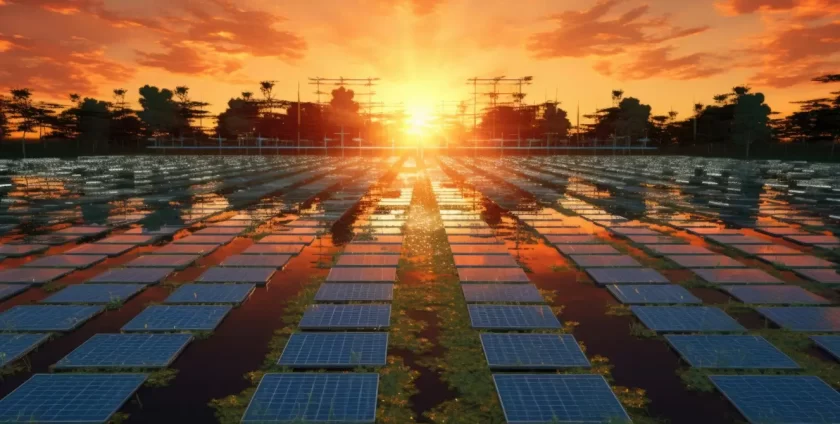
Investing in solar projects is crucial due to the promise economics and environmental impact of solar energy. Solar power is becoming increasingly cost competitive as solar energy is the cheapest new source of electricity in many developed countries.
This cost-effectiveness is a key driver for the rapid adoption of solar energy and makes it an attractive investment in solar energy in India. Furthermore, solar investments offer stable and long-term revenues supported by power purchase agreements making them financially appealing.
Solar Investment Landscape in India
The renewable energy landscape particularly in the solar industry in India has demonstrated significant growth and ambitious goals. India ranks 4th globally in renewable energy installed capacity and with a remarkable 396% growth in the last 8.5 years.
Moreover, India has implemented favorable policies to boost solar electricity generation, such as the Production Linked Incentive (PLI) Scheme and Suryodhya Yojana.
Steps to Invest in Solar Projects in India
Investing in solar projects and industrial solar panels in India requires a systematic approach to ensure success and sustainability. Below are the detailed steps to be followed for how to invest in solar projects:
1. Market Research and Understanding
Market research plays a crucial role in understanding the dynamics of the solar industry in India. It helps investors identify opportunities, assess competition and also understand consumer preferences.
2. Project Planning
Investors need to define their interest in solar energy in India strategy and whether it is focused on utility scale solar projects and rooftop solar installations and or other segments of the solar market. Clear project goals help in aligning resources and efforts effectively.
Types of solar projects to consider:
India offers various solar project types such as utility scale solar parks, rooftop solar for commercial, and industrial buildings, solar mini-grids for rural electrification and solar pumps for agricultural use. Investors should choose a project type based on their objectives, expertise and available resources.
Financial Planning
Conduct a detailed financial analysis to determine the budget required for the solar project. Consider factors such as equipment costs, installation expenses, operation, maintenance costs, and potential revenue streams from power generation.
Different financing models available for solar projects:
In India, solar projects can be financed through various models like debt financing, equity financing, power purchase agreements (PPAs), leasing and government incentives such as subsidies on tax benefits. evaluate these options to determine the most suitable financing model for your project.
1. Regulatory and Legal Compliance
Familiarize yourself with the regulatory requirements for solar projects in India including permits, licenses, environmental clearances, land acquisition, and grid connectivity approvals. Compliance with these regulations is essential to avoid legal issues and delays.
2. Technology Selection
Decide on the solar technology based on project requirements, location, resource availability, and a budget. PV technology is commonly used for rooftop small scale installations while CSP is suitable for utility scale projects with high solar irradiation.
Consider the efficiency, reliability, maintenance requirements, and cost-effectiveness of the chosen technology. PV systems are more mature and cost-effective for most applications. While CSP offers advantages in terms of energy storage and thermal applications.
Financing Solar Projects
Here’s an overview of different financing options for solar projects and the risks associated with financing solar panels:
1. Bank Financing
This involves taking a loan from a bank or financial institution to finance the solar project. The borrower repays the loan amount along with interest over a specified period.
Access to capital without giving up equity and potential tax benefits and fixed interest rates in some cases.
High upfront costs, interest rate fluctuations stringent eligibility criteria and potential for default if the project doesn’t generate expected returns.
2. Angel Investors and High-Worth Individuals
These are individuals or groups who invest their capital in exchange for equity or a share of project profits.
Dilution of ownership and potential conflicts over decision making and reliance on investor’s financial stability.
3. Power Purchase Agreements (PPAs)
A PPA involves a third-party investor or developer who owns and operates the solar system on a customer’s property. The customer agrees to purchase the electricity generated at a predetermined rate over a set period.
No upfront costs for the customer and predictable energy costs and potential for long-term savings.
Dependency on the PPA provider’s performance, maintenance, fluctuating energy prices and contractual obligations.
Conclusion
Investing in the solar industry demands strategic analysis of market trends, financial viability and risk mitigation. Understanding growth potential and conducting thorough financial assessments and diversifying portfolios across solar segments and regions are key.
Sustainability considerations and partnerships with experienced players further enhance investment success. With a focus on long term resilience, alignment with sustainability goals and solar investments offer opportunities for attractive returns while contributing positively to a cleaner and renewable energy landscape.
- By: jjpvsolar
- 0 comment


Leave a Reply